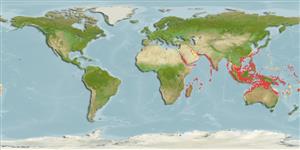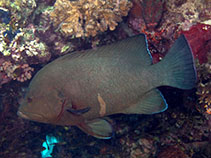Aethaloperca rogaa (Fabricius, 1775)
Redmouth grouper
Add your observation in Fish Watcher
| Native range | All suitable habitat | Point map | Year 2050 |

|
| This map was computer-generated and has not yet been reviewed. |
| Aethaloperca rogaa AquaMaps Data sources: GBIF OBIS |
Upload your photos and videos
Pictures | Videos | Google imageAethaloperca rogaa
Picture by De Vroe, J.
Pictures | Videos | Google imageAethaloperca rogaa
Picture by De Vroe, J.
Classification / Names প্রচলিত নাম সমূহ | প্রতিনাম সমূহ | Catalog of Fishes(গণ , প্রজাতি ) | ITIS | CoL | WoRMS | Cloffa
> Perciformes/Serranoidei (Groupers) > Epinephelidae (Groupers)
Etymology: Aethaloperca: Greek, aithalos, -ou = soot, black, ash + Greek, perke = perch (Ref. 45335).
Etymology: Aethaloperca: Greek, aithalos, -ou = soot, black, ash + Greek, perke = perch (Ref. 45335).
Environment: milieu / climate zone / depth range / distribution range বাস্তুসংস্থান
সামুদ্রিক রীফ সংশ্লিষ্ট; অ_ পরিযায়ী; গভীরতার পরিসীমা 3 - 60 m (Ref. 68964), usually 3 - 60 m (Ref. 5222). Tropical; 31°N - 31°S, 30°E - 178°W (Ref. 5222)
বিতরণ দেশ সমূহ | এফ এ ও এলাকাসমূহ | বাস্তুতন্ত্র | দৃষ্টিগোচর | Point map | প্রচলন | Faunafri
Indo-West Pacific: Red Sea to South Africa and east to the Gilbert Islands. Probably found in all tropical islands of the Indian Ocean. Also reported from Persian Gulf (Ref. 68964). Recorded from Europa Island (MNHN 1992-0475, Ref. 33390).
Length at first maturity / আকৃতি / ওজন / Age
Short description সনাক্তকারী নির্দেশক | বহিঃ অঙ্গ সংস্থান | মরফোমেট্রিক্স
পৃষ্ঠীয় কাঁটা (মোট ) : 9; পৃষ্ঠীয় নরম পাখনা দন্ড (মোট ) : 17 - 18; পায়ূ কাঁটা : 3; পায়ূর নরম পাখনা্তুন্ড: 8 - 9. This species is distinguished by the following characters: deep and compressed body with greatest depth 2.1-2.4 in SL; dorsal head profile steep, straight, or slightly concave along snout and distinctly convex from eye to dorsal fin; longitudinal scale series 94-104; gill rakers 8-11 + 15-17; in adults the middle dorsal and anal-fin rays are elongated, giving these fins an angular profile, with the rear margin almost vertical; caudal fin truncate, 8 branched rays in upper lobe and 7 in lower lobe; pectoral fins asymmetric, 17-19 rays. Colour of body dark brown to black, occasionally with an orange cast, usually with a pale vertical bar on side of abdomen; inside of mouth, gill cavity and upper jaw membranes reddish orange; juveniles with a broad white posterior margin on caudal fin and a narrow white margin on soft dorsal fin (Ref 5222).
Adults are found in coastal reefs and lagoons, often on silty habitat (Ref. 48635), in or near caves and holes in the reef. They feed mainly on small fishes (including Pempheris sp.), also on stomatopods (Pseudosquilla sp.) (Ref. 6448); and crustaceans (Ref. 37816). Preliminary data indicate that mature individuals spawn at any time of the year and mature (females?) at about 35 cm SL (Ref. 6448). Small juveniles mimic Centropyge vrolikii (Ref. 8631), and C. nox until they outgrow their model in size (Ref. 48635). Taken as part of the live reef food fish trade centered in China and In Hong Kong and are occasionally found in markets (Ref. 89707). They are caught with hook-and-line, spear, and probably in traps (Ref. 39231).
Life cycle and mating behavior পরিপক্কতা | প্রজনন | ডিম ছাড়া | ডিমসমূহ | ডিম্বধারন ক্ষমতা | শুককীট
Main reference
Upload your references | সূত্র সংখ্যা | সমম্বয়কারী | সহযোগী
Heemstra, P.C. and J.E. Randall, 1993. FAO Species Catalogue. Vol. 16. Groupers of the world (family Serranidae, subfamily Epinephelinae). An annotated and illustrated catalogue of the grouper, rockcod, hind, coral grouper and lyretail species known to date. Rome: FAO. FAO Fish. Synop. 125(16):382 p. (Ref. 5222)
IUCN Red List Status (Ref. 130435: Version 2024-2)
Least Concern (LC) ; Date assessed: 17 November 2016
CITES
Not Evaluated
Threat to humans
Harmless
Human uses
মৎস্য: গৌণ বাণিজ্যিক ; শিকারযোগ্য মাছ: হঁ্যা
FAO - মৎস্য: landings; Publication: search | FishSource | আমাদের চতুর্পাশ্বের সাগর
আরো তথ্য
Population dynamics
Growth parameters
Max. ages / sizes
Length-weight rel.
Length-length rel.
Length-frequencies
Mass conversion
নির্বাচন
প্রাচুর্য
Growth parameters
Max. ages / sizes
Length-weight rel.
Length-length rel.
Length-frequencies
Mass conversion
নির্বাচন
প্রাচুর্য
Life cycle
প্রজনন
পরিপক্কতা
Maturity/Gills rel.
ডিম্বধারন ক্ষমতা
ডিম ছাড়া
Spawning aggregations
ডিমসমূহ
Egg development
শুককীট
শুককীটের সত্রিুয়তা
প্রজনন
পরিপক্কতা
Maturity/Gills rel.
ডিম্বধারন ক্ষমতা
ডিম ছাড়া
Spawning aggregations
ডিমসমূহ
Egg development
শুককীট
শুককীটের সত্রিুয়তা
Anatomy
ফুলকা এলাকা
Brain
Otolith
ফুলকা এলাকা
Brain
Otolith
Physiology
Body composition
Nutrients
অম্লজান ব্যবহার
-এর সাতাঁরের ধরণ
সাতাঁরের গতি
Visual pigments
Fish sound
Diseases & Parasites
Toxicity (LC50s)
Body composition
Nutrients
অম্লজান ব্যবহার
-এর সাতাঁরের ধরণ
সাতাঁরের গতি
Visual pigments
Fish sound
Diseases & Parasites
Toxicity (LC50s)
Genetics
বংশানুগতিবিদ্যা
Heterozygosity
উতরাধিকার সুত্রে পাওয়া যোগ্যতা
বংশানুগতিবিদ্যা
Heterozygosity
উতরাধিকার সুত্রে পাওয়া যোগ্যতা
Human related
Aquaculture systems
একুয়াকালচার নকশাসমূহ
বংশ
Ciguatera cases
Stamps, coins, misc.
Aquaculture systems
একুয়াকালচার নকশাসমূহ
বংশ
Ciguatera cases
Stamps, coins, misc.
হাতিয়ার
Bio-Quiz | E-book | মাঠ পর্যায়ের নির্দেশক | সনাক্তকারী নির্দেশক | দৈঘ্যর্ের ঘটন সংখ্যা জাদুকর | জীবন ইতিহাস হাতিয়ার | মানচিত্র নির্দেশ করুন | Classification Tree
| Catch-MSY |
Special reports
Download XML
ইন্টারনেট সুত্র
AFORO (otoliths) | Aquatic Commons | BHL | Cloffa | BOLDSystems | Websites from users | Check FishWatcher | CISTI | Catalog of Fishes: গণ , প্রজাতি | DiscoverLife | ECOTOX | FAO - মৎস্য: landings; Publication: search | Faunafri | Fishipedia | Fishtrace | GenBank: genome, nucleotide | GloBI | Google Books | Google Scholar | Google | IGFA World Record | MitoFish | জাতীয় উপাত্ত সমূহ | Otolith Atlas of Taiwan Fishes | PubMed | Reef Life Survey | Socotra Atlas | জীবন বৃক্ষ | Wikipedia: Go, অনুসন্ধান | World Records Freshwater Fishing | জুলজিকাল রেকর্ড
Estimates based on models
Preferred temperature (Ref. 123201): 24.1 - 29, mean 27.9 °C (based on 2908 cells).
Phylogenetic diversity index (Ref. 82804): PD50 = 1.0000 [Uniqueness, from 0.5 = low to 2.0 = high].
Bayesian length-weight: a=0.01288 (0.00534 - 0.03106), b=3.06 (2.85 - 3.27), in cm total length, based on LWR estimates for this (Sub)family-body shape (Ref. 93245).
ট্রফিক পর্যায়ে (Ref. 69278): 4.1 ±0.68 se; based on food items.
স্থিতিস্থাপক (Ref. 120179): মাধ্যম , সর্বনিম্ন প্রজন দ্বিগুনের সময় ১.৪-৪.৪ বৎসর (Preliminary K or Fecundity.).
Fishing Vulnerability (Ref. 59153): Moderate vulnerability (44 of 100).
Climate Vulnerability (Ref. 125649): Moderate to high vulnerability (50 of 100).
Nutrients (Ref. 124155): Calcium = 34.1 [19.5, 56.8] mg/100g; Iron = 0.311 [0.151, 0.637] mg/100g; Protein = 18.1 [16.2, 19.9] %; Omega3 = 0.136 [0.087, 0.211] g/100g; Selenium = 58.8 [33.8, 105.5] μg/100g; VitaminA = 91.2 [25.0, 388.5] μg/100g; Zinc = 0.488 [0.315, 2.800] mg/100g (wet weight); based on nutrient studies.




